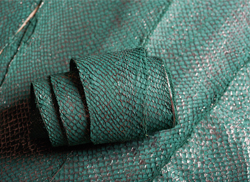
Before Owino started making leather from fish skin, fillet firms were dumping 150 tonnes of fish waste, 80 per cent of which was skin, on the beach.
This was posing environmental and health hazards. On an early afternoon at Kajulu village, Kisumu East Sub county, Newton Owino tries on a new pair of shoes.
The material used to make this particular pair of shoes is black in colour, with some few grey stripes. One could easily conclude that it was made of ‘normal’ leather.However, as he explains, the shoe is actually made of 100 per cent fish leather.
The black part is made of tanned catfish leather, while the stripped part is tanned Nile perch leather. On the walls of his iron-sheet made office are fish leather products, mainly shoes of several kinds as well as caps. Owino, a leather expert, recycles fish skin, by tanning it to leather. This technology does not only solve an environmental pollution crisis, but also creates a source of income for more than 80 people locally.
His journey to tanning fish leather dates back to 2012, when he discovered there was too much of it being disposed of by processors on the shores of Lake Victoria. “Fish skin was going to waste along Lake Victoria and this was causing a crisis between the fillet industry owners and environment authorities,” he says.
Besides, he adds, he envied other regions in the country that exported products and produce, while his Kisumu locality was not thriving in the export sector. He embarked on a research mission to see how he would solve the tussle, and that was how he ended up in the fish leather tanning industry.
Every year, about 150 tonnes of fish waste is produced by filleting firms. 80 percent of the waste was fish skin, which was posing environmental and health hazard, especially in the nearby Ibongo slum. To process the fish leather, he has mobilised 78 women, who collect raw fish skin from the filleting firms. Owino has already trained the women on proper scaling without destroying the skin. This process involves soaking the skins in water to soften them, and scrapping off the scales.
This is known as the pre-tanning process. At this stage, the fish skin is known as pelt. Although the women had offered him Sh5 for each pelt, he opted to buy the same at Sh50. Reason? “I am a member of the World Trade Organisation (WTO) and one of the conditions of membership is that you must offer fair compensation for goods and services delivered,” he says.
The second stage is tanning where the pelt is turned into leather. It starts with pickling, which is balancing the PH of the skin, so that it can absorb the tanning agents.
“In pickling, we soak the skin in water mixed with lemon leaves for about three hours. The acidic water opens up the pores in the pelt, so that it can easily and effectively absorb the tanning agents,” explains Owino.
The skin is then soaked in a banana roots solution for three days which it absorbs, causing it to toughen. Afterwards, the skin is removed and washed in clean water. At this stage, its name changes to ‘wet white leather’, Although it is still hard it is good enough for export to Iceland, Ethiopia, Italy and USA. He sells it for Sh650 per square foot, exclusive of shipping and other costs. Annually, he exports about 800 square feet of fish leather.
For final products, the ‘wet white leather’ is soaked in warm water and essential oils. At this point it is called a ‘crust’ while the process is known as ‘crusting’. While he processes mainly Nile Perch skin from Lake Victoria, he also buys catfish skin mainly from Meru.
He gets his clients through linkages by the Kenya Leather Development Council, as well as through exchange of ideas with other members of the WTO In 2015, an innovative Owino was awarded by the Leipzig University of Germany for his excellence and contribution in the leather industry.
